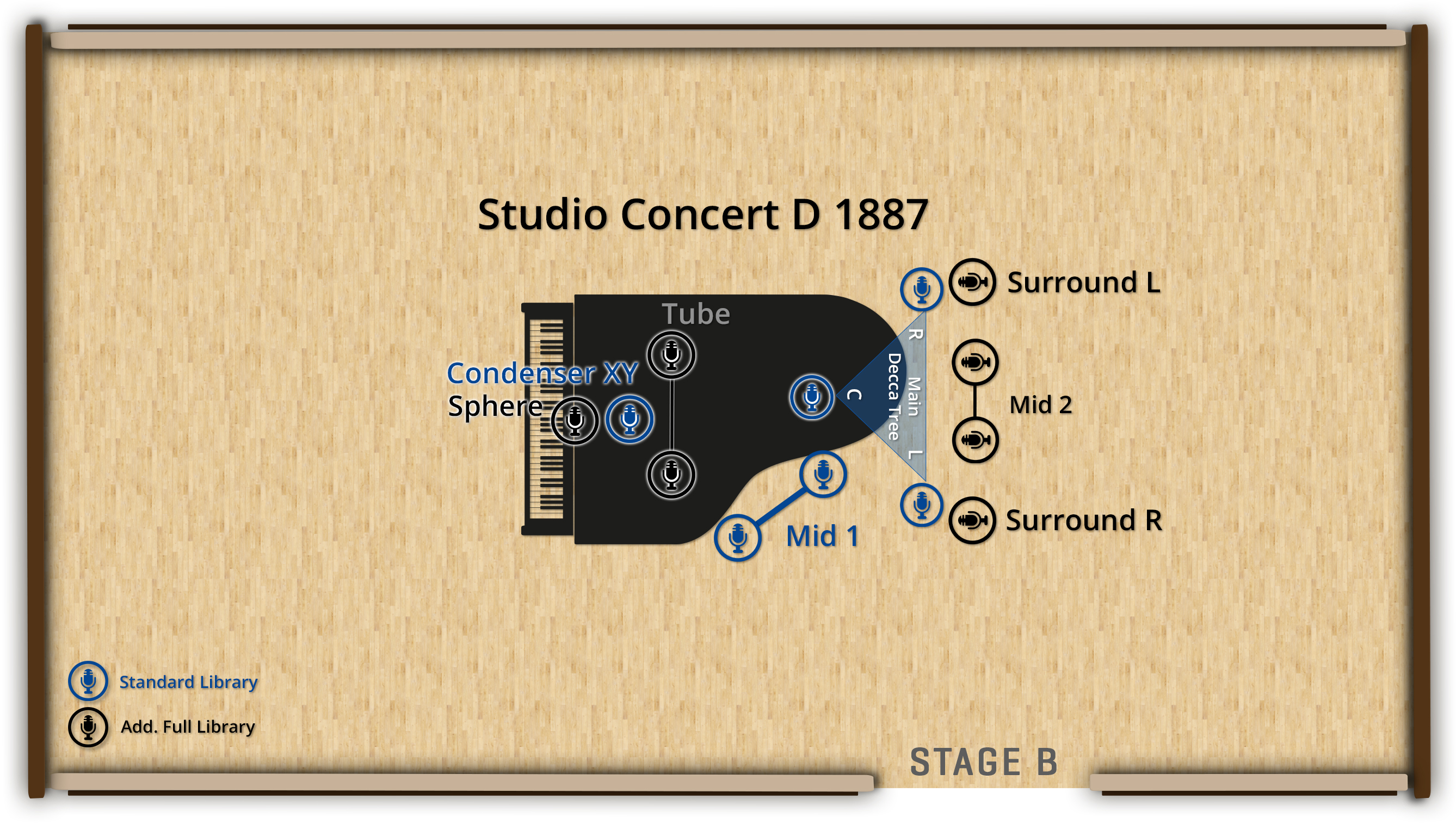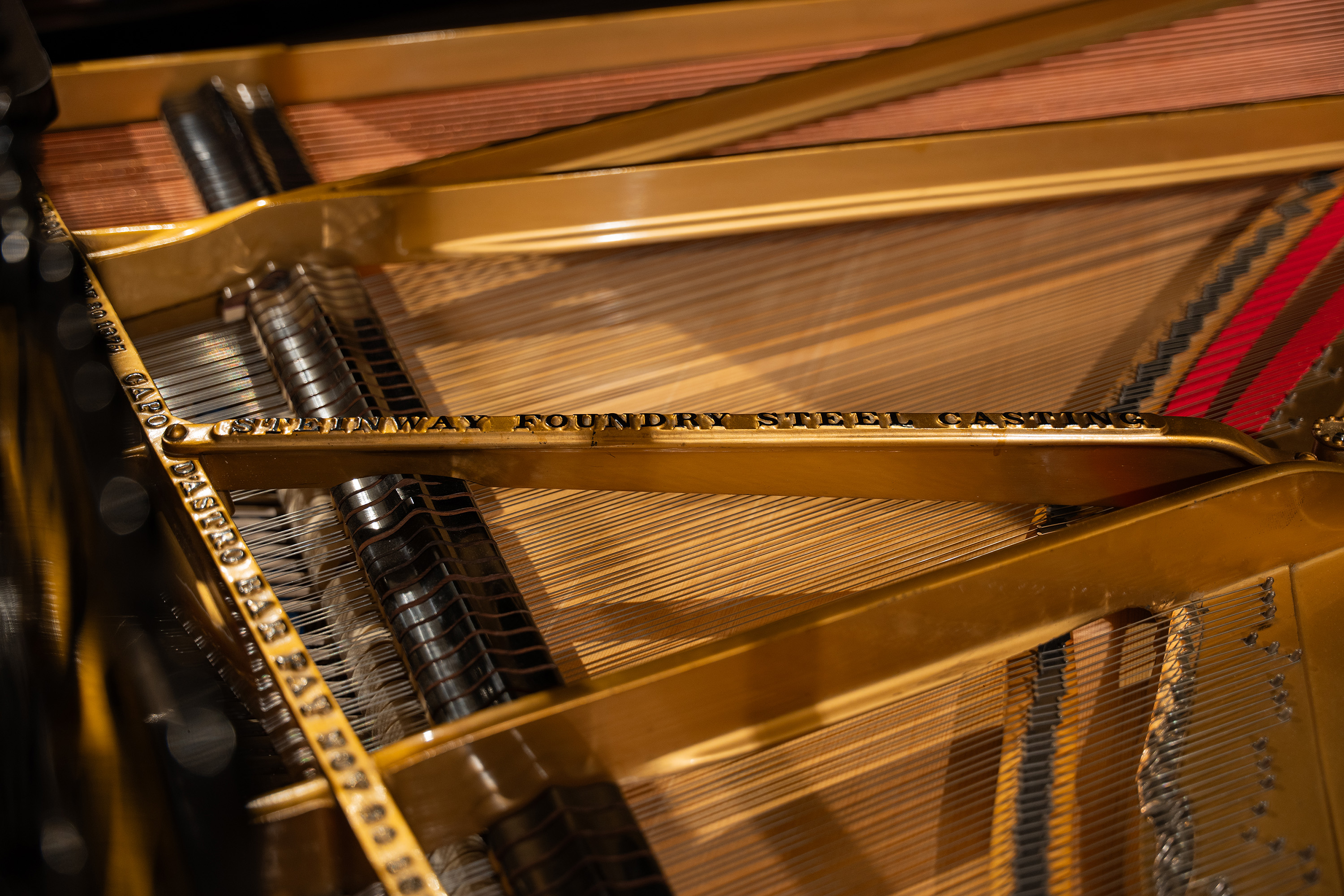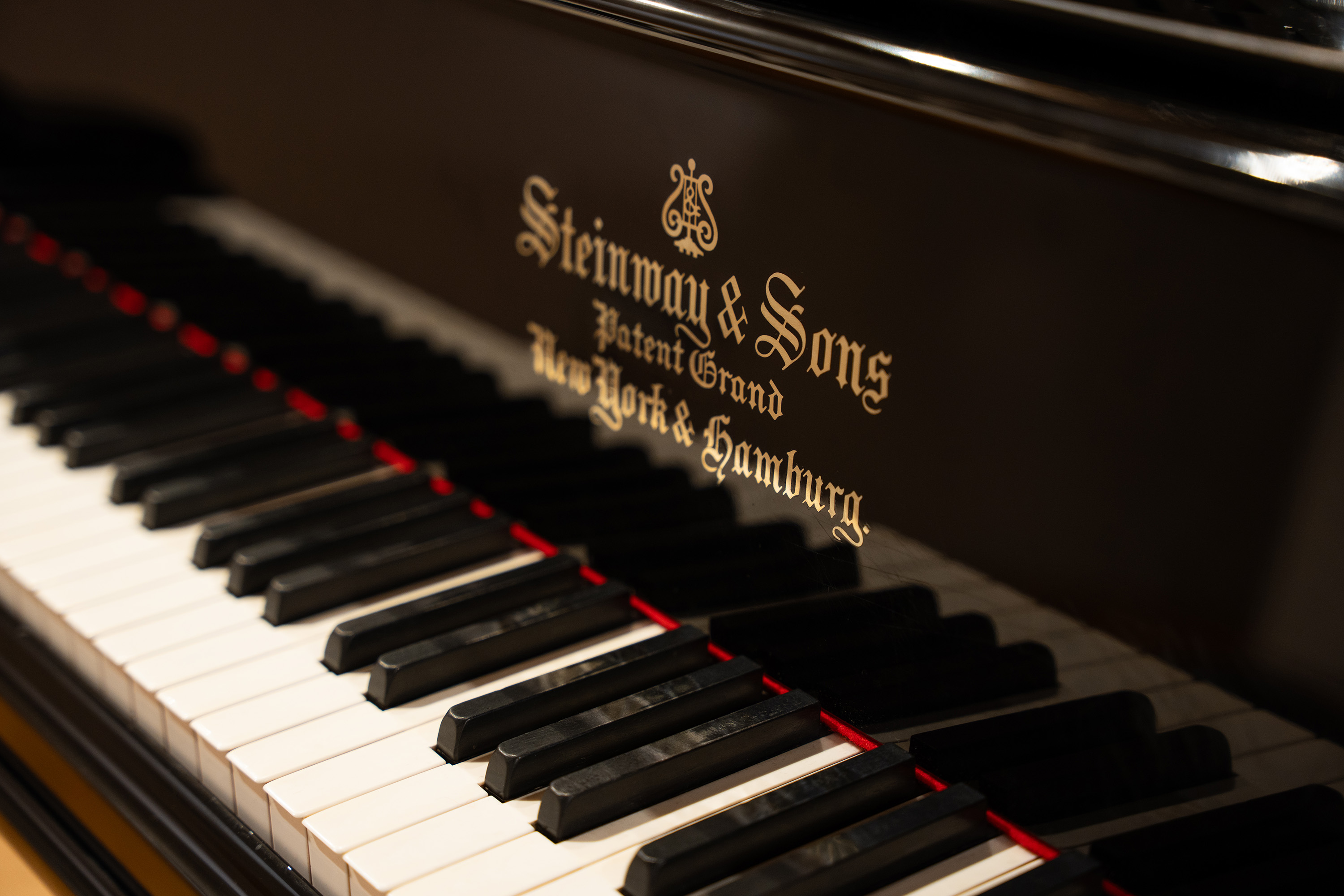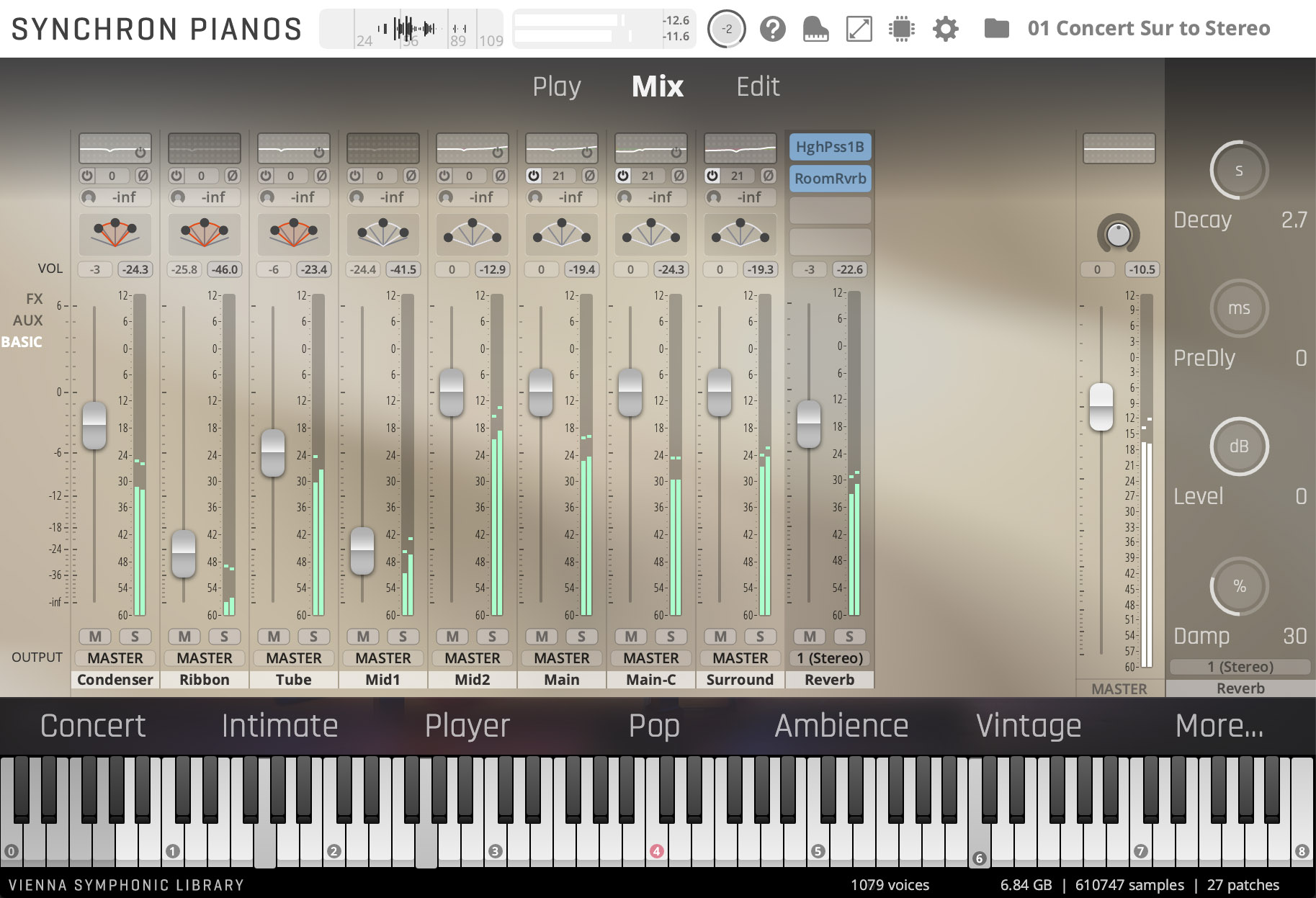The Studio Concert D 1887 brings to life the sound of the rare and lyrical voice of a remarkable early Steinway D concert grand, serial no. 62523 – the only known instrument of its series (1884–1892) that has actually been preserved in its original condition and professionally restored. This unique piano represents a fascinating moment in Steinway & Sons’ evolution, bridging 19th-century craftsmanship with the innovations to come. Distinct from later Model Ds, it features an additional duplex scale and angled bridge pins that create different string lengths for each note, resulting in a lyrical, singing tone unlike any other concert grand of its time.
Having spent nearly 140 years in what can only be described as a time capsule, this piano was found in astonishingly original condition. Every part of its mechanism was preserved, including the original hammerheads, which were expertly reworked to revive the instrument’s authentic 1887 sound. Only three components were replaced during restoration – new strings, historically correct blued tuning pins, and red bearing felts – ensuring that its original substance remained virtually untouched.
In order to capture this instrument on Stage B, our recording engineers used multiple high-end microphone arrays, affording an abundance of options for creating your individual sound. The Full Library features 8 microphone positions – three different sets of close microphones with condenser, ribbon and tube options, two pairs of mid mics, as well as the Decca tree with additional surround outriggers.

Room Mic (Mix):
The Room Mix channel contains a stereo mix of all available room microphones from the Full Library.Condenser - Close 1 (Sennheiser MKH 8040):
"XY" setup with a pair of Sennheiser MKH 8040 positioned as closely as possible over the hammer area. Ideal for producing the typical "pop piano" sound.Mid 1 (Lewitt LCT 540S):
Setup with a pair of Lewitt LCT 540S mics behind the piano for a warm and dark timbre.Main/Room Mic (L/R) - Decca Tree Stereo (DPA 4006):
Decca Tree array (L-C-R) with three DPA 4006 mics. These very neutral microphones capture even the smallest detail of the studio. Used in a stereo mix, you can easily hear where the piano is placed. In a surround setup, the Decca tree microphones will be the feed for your front L-R speakers.Main/Room Mic Center - Decca Tree Mono (DPA 4006)
Even if you're not using a surround setup, you get more ambiance variation and spatial depth out of the Full Library by adding the room microphones' signals to your stereo mix.
Sphere - Close 2 (Schoeps KFM6):
Setup with two Schoeps KFM6 mics, for a fast, direct, and natural sound.Tube - Close 3 (Lewitt LCT 1040):
Setup of a Lewitt LCT 1040 stereo pair, capturing the piano sound's beauty with the analog warmth and richness of an exceptional tube microphone.Mid 2 (Sennheiser MKH 800):
A-B stereo setup with a pair of Sennheiser MKH 800 mics for a wider, warmer, and centered sound.Main Surround - Stereo (Sennheiser MKH 8020):
Wide A-B stereo setup with two Sennheiser MKH 8020 omni directional microphones. In a surround setup, these signals would be used for your rear speakers.
The instrument Presets also include different mixer presets. By default the classic room mixes are loaded which include the Standard Library microphone positions. These are balanced in the stereo field to represent the instrument's position in the Synchron Stage set-up.
Auro 3D is an immersive audio technology that allows for three-dimensional sound perception. The Belgian company Auro Technologies developed this technology based on a special speaker configuration, adding four additional speakers to a 5.1 surround configuration. These speakers (so-called "Heights'') are situated above the front and surround speakers and generate acoustic reflections that are perceived naturally due to the fact that sounds originate from around as well as from above the listener. Thanks to the comprehensive selection of discrete audio channels the Full Library allows you to mix your instruments in Auro 3D as well as in Dolby Atmos.

About Pitch
For designating pitch, the Vienna Symphonic Library uses International Pitch Notation (IPN), which was agreed upon internationally under the auspices of the Acoustical Society of America. In this system the international standard of A=440 Hz is called A4 and middle C is C4. All pitches are written as capital letters, their respective octave being indicated by a number next to it. The lowest C on the piano is C1 (the A below that is A0), etc.
Unique early Steinway & Sons Concert Grand Model D, built in 1887
Duplex scale and angled bridge pins create a uniquely lyrical tone
Historically faithful restoration with nearly all original parts retained
Recorded at Stage B of Vienna Synchron Stage
Multiple microphone positions for a variety of timbral variations
Pre-configured mixer presets and additional FX presets

To capture the Synchron Pianos with all their subtleties, our engineers developed a highly precise motion-control system based on a solenoid that controls a noise-free "robot finger". The micro-controller moves the finger with super-human precision, providing flexible curvatures for down-strokes and release movements. The MIDI controlled system delivers more than 100 velocities and various release samples, depending on the preceding note length and various release speeds.
This innovation represents the pinnacle of our long-term sampling robotics development. An earlier version of the robot finger was used for sampling the Celeste found in our Synchron Percussion I Collection.
In addition to creating your sound by mixing several microphone signals, the free Vienna Synchron Pianos software offers multiple options for shaping the sound of the piano and your playing experience. Hosting a high-performance playback engine, the software provides a full-blown mixer with a broad range of effects such as EQ, compressor, saturator, algorithmic reverb, delay, chorus, flanger, rotary, and many more. You may also adjust the volume of body resonances, sympathetic strings, and pedal noises right in the main Play window. In the Edit window you can even tweak EQ, volume, tuning, dynamic range, etc. for each individual key!

In the browser window of the Synchron Pianos player you may select from four general preset categories
Ready-made, resource saving presets with as few microphones as possible. The "Room Mix" Channel contains a mix of all available microphones from the Full Library.
The classic sound of a Decca tree stereo recording features a more slender sound with less diffusion compared to the "Room Mix" Presets.
These presets include all available room microphones with various runtime delays, creating more diversity in the perception of room depth.
Designed to send the microphone signals to your available surround channels.
Our engineers captured the rich resonances of the piano’s warm, colorful, and sparkling sound with an array of phase-aligned microphones, all of them separately available in the mixer section of the Synchron Piano Player, and perfectly pre-configured with Mixer Presets which lets you focus on your music. The Synchron Pianos player interface offers instant and direct access to seven pre-configured character presets.
Preset Comparison
Concert:
Character: Classic stereo version of the Fazioli F212, with added Room Reverb.
Perspective: Conductor, centered.
Recommendation: Ideal placement in your orchestra, compatible with all Synchron Series products.Intimate:
Character: Dark, warm and close sound with a focus on the condenser close microphone and a gentle touch of the stage. Added plate reverb to enrich the sound.
Perspective: Player, centered.
Recommendation: For ballads and intimate settings.Player:
Character: Immediate response with full stereo width of the keyboard and a natural room response. Authentic and direct.
Perspective: Player, centered.
Recommendation: Ideal recording preset for pianists, the pure playing experience.Pop:
Character: Powerful and assertive, with added compression in the close microphone. Increased MIDI Sensitivity. Room Reverb with a short reverb. Decca Main microphones are delayed to create a short slap-back sound.
Perspective: Player, centered.
Recommendation: For the modern songwriter, for live solo performances and within a band context.Ambience:
Character: A spacious yet assertive sound with a lot of algorithmic reverb to add a spacious impression.
Perspective: Conductor, piano centered.
Recommendation: For film scores, elated piano melodies and an impressive piano sound in the background.Vintage:
Character: Narrowed stereo image with a phasing effect and a delayed plate reverb, with a cabinet speaker, phaser and compressor on some microphones.
Perspective: Conductor, centered.
Recommendation: Great for intimate accompaniment and a "personal" sound.
FX Presets
The specially designed FX Presets offer an easy way to achieve more drastic changes to the sound of your Fazioli F212, and transform it for pop and electronica applications! Here’s a list of the available FX Presets.
01 Evolution
A spacious sound with a synced delay.
02 Diamonds in the Night
Fragile chorus piano with a magical aftermath.
03 Reality Check
Discreet 80ies piano, great for accompaniment.
04 Stadium
Bigger than life, with a slapback echo.
05 Time Warp
Dreamy keys with intense use of delays.
06 Wormhole
Reverse FX in combination with delays create a Bluthner from another galaxy.
07 Magic Doors
Distant E-piano with a singing tone.
08 Blunt but Friendly
A harmless but useful flat piano sound.
09 Fuzzmaster
Slightly distorted stage piano.
10 Harpsichord
A classic harpsichord sound.
11 Candy Cotton
A muffled piano, for reflective moments.
12 Donnie
Dark piano in a large hall.
13 Glittering Clouds
Modified attacks with delays in a shiny room.
14 High and Mighty
Singing, hovering piano sound with a very light sonic appearance.
15 Morphology
Shimmering FX on a shiny piano sound.
16 From a Distance
A warm piano sound from far away.
17 Megatrump
Thinned-out pop piano with a great level of built-in distortion.
18 Pierce
Shivering piano in a beautiful hall.
19 Intimate Timbre
Alternative version to the classic Intimate preset, with added Timbre Shift.
20 Pop Timbre
Alternative version to the classic Pop preset, with added Timbre Shift.
21 Vintage Timbre
Alternative version to the classic Vintage preset, with added Timbre Shift.